LED Lighting Ideas For Bedroom Room: Ideas And Inspiration
Transforming your living room into a haven of comfort and style starts with the right lighting. This comprehensive guide explores a wide range of LED lighting ideas for living room, helping you choose the perfect ambiance for relaxation, entertainment, or any mood you desire. We’ll cover everything from the basics of LED lighting to advanced…
Transforming your living room into a haven of comfort and style starts with the right lighting. This comprehensive guide explores a wide range of LED lighting ideas for living room, helping you choose the perfect ambiance for relaxation, entertainment, or any mood you desire. We’ll cover everything from the basics of LED lighting to advanced techniques, ensuring you understand how to illuminate your space effectively and beautifully. You’ll learn about different types of LEDs, placement strategies, color temperature considerations, and smart home integration. Let’s dive in and create the living room of your dreams!
LEDs, or Light Emitting Diodes, are semiconductor devices that convert electricity into light. Unlike incandescent bulbs that produce heat as a byproduct, LEDs are significantly more energy-efficient, lasting much longer and generating less heat. This makes them an environmentally friendly
and cost-effective choice for home lighting.
Types of LED Bulbs
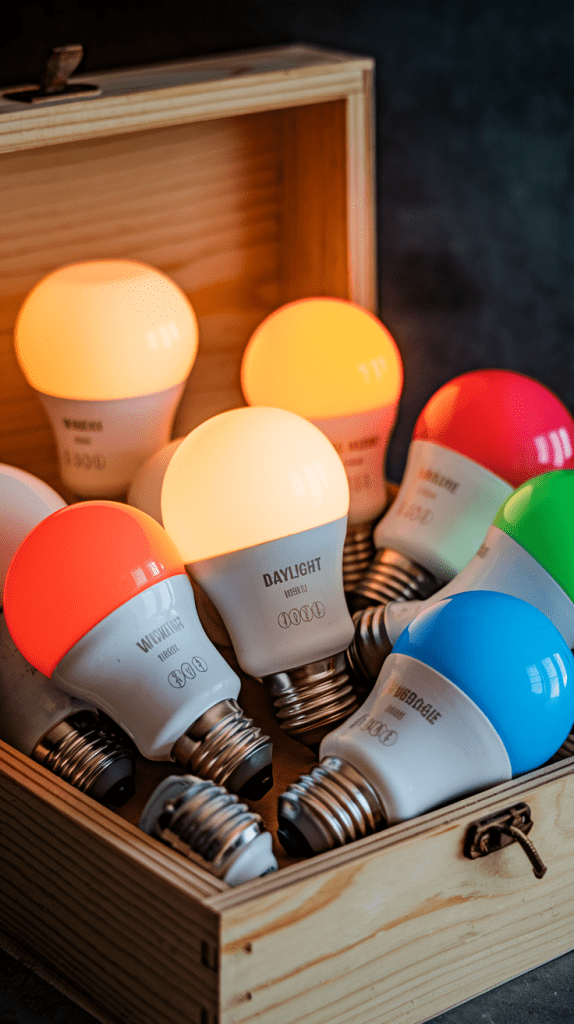
There’s a wide variety of LED bulbs available, including: A19 (standard shape), BR30 (floodlight), GU10 (recessed), PAR20 (narrow beam), and many more. Understanding bulb shapes will help you achieve specific lighting goals.
Color Temperature Explained
Color temperature is measured in Kelvin (K). Lower Kelvin values (2700K-3000K) produce warm, yellowish light, ideal for relaxation. Higher Kelvin values (5000K-6500K) produce cool, bluish light, better suited for task lighting. Choosing the right color temperature is crucial for setting the mood in your living room.
Choosing the Right LED Bulbs for Your Living Room
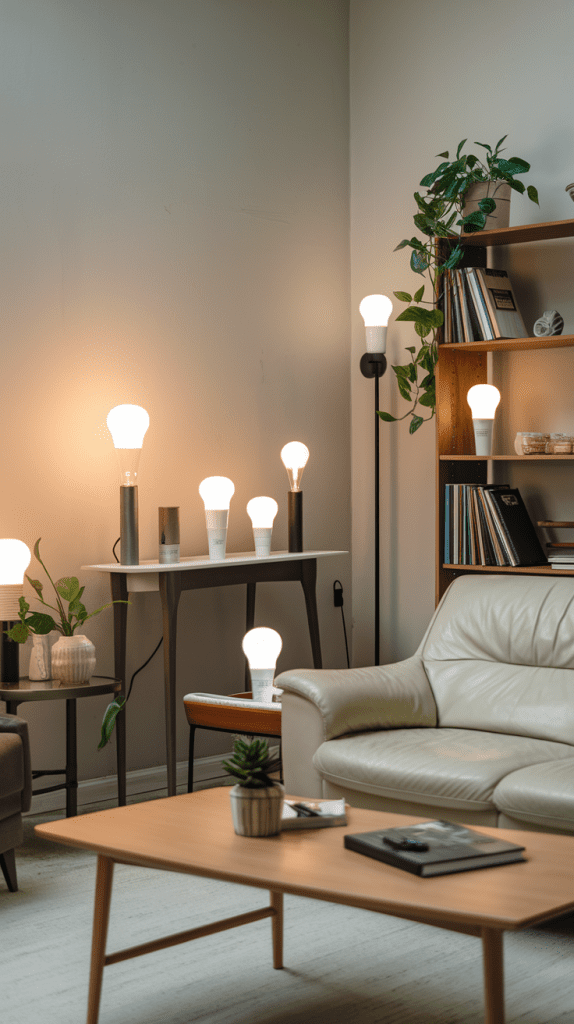
Brightness and Lumens
Brightness is measured in lumens (lm). Higher lumens mean brighter light. Consider the size of your living room and the desired brightness level when selecting LED bulbs. A larger living room will generally require higher lumen bulbs for adequate illumination.
Dimmable LEDs and the Importance of Dimmers
Many LED bulbs are dimmable, allowing you to adjust the brightness to suit different activities and moods. However, ensure both your bulbs and your dimmer switch are compatible for seamless dimming functionality. Incompatible pairings can lead to flickering or malfunction.
Energy Efficiency and Savings
LEDs are known for their energy efficiency, consuming significantly less electricity than incandescent or halogen bulbs. This translates into lower energy bills and a smaller carbon footprint, making them an environmentally conscious choice.
Creative LED Lighting Ideas for Your Living Room
Ambient Lighting
Ambient lighting provides overall illumination. Recessed lighting, ceiling fixtures, or even strategically placed floor lamps with warm-toned LED bulbs can create a cozy and inviting atmosphere.
Task Lighting
Task lighting focuses light on specific areas for particular activities, such as reading or working. Desk lamps, pendant lights above a reading nook, or strategically placed track lighting with adjustable heads are all excellent options.
Accent Lighting
Accent lighting highlights architectural features or decorative elements, adding visual interest to your living room. LED strip lights under cabinets, behind artwork, or along shelves can dramatically enhance the room’s aesthetic.
Layering Your Living Room Lighting for Optimal Ambiance
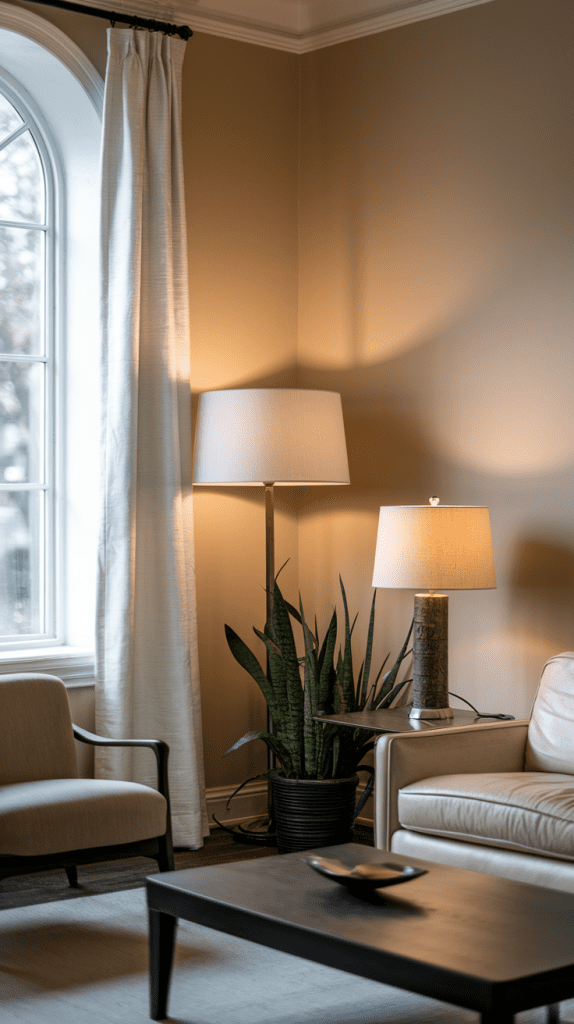
Combining Different Lighting Techniques
Combining ambient, task, and accent lighting allows you to create a layered lighting scheme that adapts to various needs and moods throughout the day. This versatility is crucial for achieving a comfortable and functional living space.
Understanding Lighting Layering Principles
The principle of lighting layering is about creating different light levels to achieve specific effects. For example, soft ambient light for relaxation, focused task lighting for reading, and subtle accent lighting to highlight artwork all contribute to a well-lit and versatile room.
Creating a Multi-Functional Living Space with Strategic Lighting
Careful planning of your lighting scheme will allow your living room to easily transition from a relaxing evening space to a vibrant entertaining area with simple adjustments to your light levels and colors.
Smart LED Lighting and Home Automation
Smart Bulbs and Their Capabilities
Smart LED bulbs connect to your home Wi-Fi network, offering features like remote control, scheduling, and color customization. You can change the color and brightness of your lights with a smartphone app, voice assistants (like Alexa or Google Assistant), or even pre-programmed schedules.
Integrating Smart Lighting into Your Smart Home Ecosystem
Integrating smart LED lighting into your broader smart home ecosystem allows for automation and seamless control across devices. You can create personalized scenes for various activities or integrate with other smart home devices for a fully automated lighting experience.
Benefits of Smart Home Integration
Smart lighting offers convenience, energy savings, and enhanced home security. Automation features such as programmed lighting schedules help save energy and create a sense of occupancy even when you are away from home, deterring potential intruders.
Installation and Setup of LED Lighting
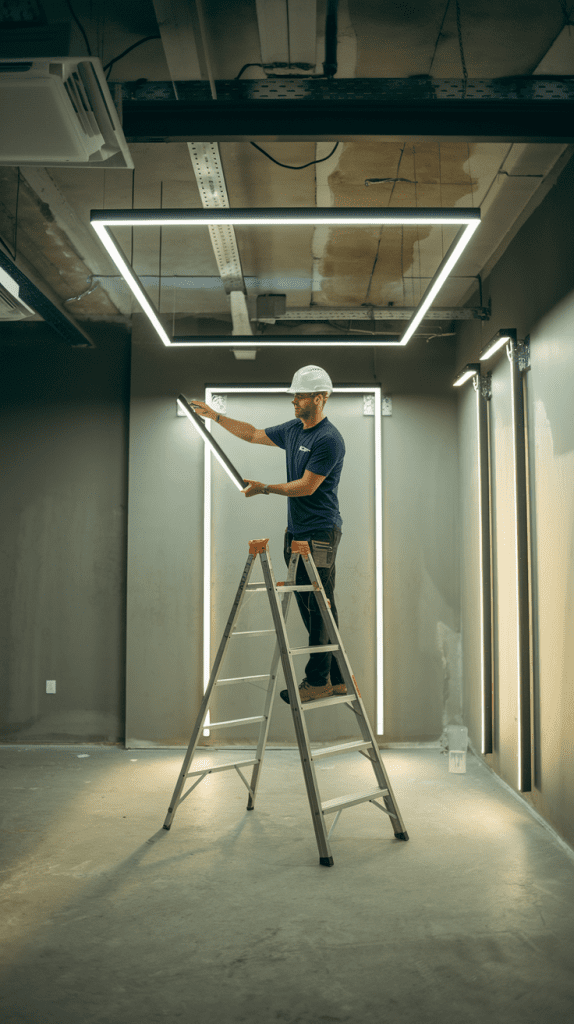
Choosing the Right Fixtures and Fittings
Select fixtures compatible with your chosen LED bulbs. Ensure you choose fixtures that match your living room’s style and integrate seamlessly with your existing décor. Proper fixture selection will ensure longevity and functionality of your new LED lighting.
Basic Wiring and Electrical Considerations
While many LED bulb replacements are straightforward, more complex installations may require the expertise of a qualified electrician. Always prioritize safety and consult a professional when needed. Working with electricity requires careful attention to safety precautions.
Troubleshooting Common Issues
Common issues include flickering bulbs, non-functional bulbs, or dimming problems. These often stem from compatibility issues between bulbs and dimmers or wiring problems. Refer to manufacturer instructions or consult a qualified electrician for assistance.
Cost Comparison: LEDs vs. Traditional Bulbs
Initial Investment vs. Long-Term Savings
LEDs have a higher initial cost compared to traditional incandescent bulbs, but their significantly longer lifespan and lower energy consumption quickly outweigh the initial investment. The long-term savings are substantial, leading to substantial cost savings over time.
Calculating Return on Investment (ROI)
Calculating your ROI involves comparing the initial cost of LED bulbs to the savings generated by reduced energy consumption over their lifetime. Consider factors such as bulb lifespan, electricity prices, and the number of bulbs you replace.
Factors Affecting the Total Cost
The total cost depends on factors such as the number of bulbs you’re replacing, the type of LED bulbs (smart bulbs are typically more expensive), and the installation complexity. Always factor in all potential costs before making your purchases.
Choosing the Right LED Color Temperature for Your Living Room
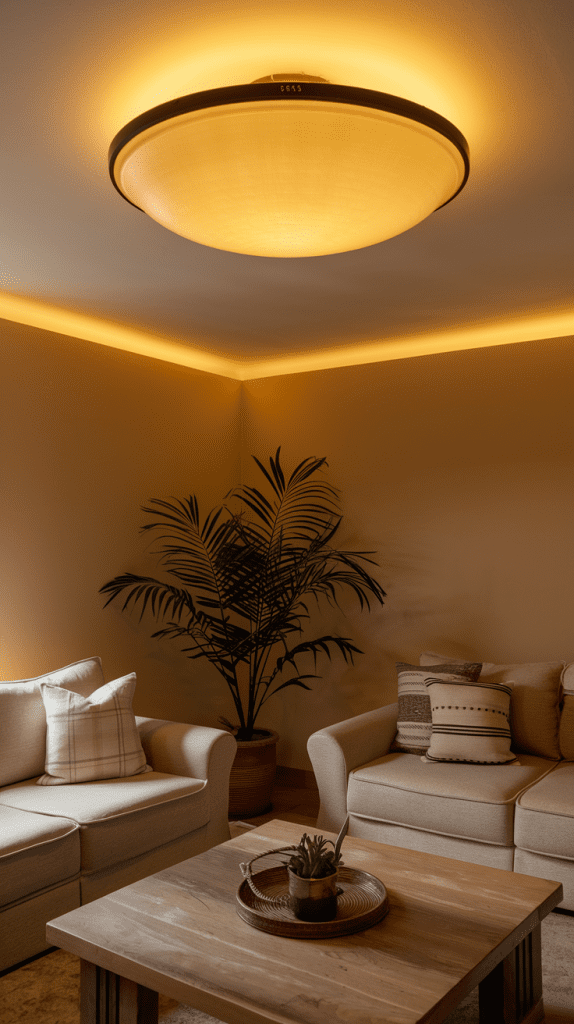
Warm White (2700K-3000K) vs. Cool White (5000K-6500K)
Warm white creates a cozy and inviting atmosphere, ideal for relaxation and socializing. Cool white provides brighter, more energetic lighting suitable for task-oriented activities. The choice depends on the desired ambiance and room functionality.
Matching Color Temperature to Room Function
Consider how the room will be used. Warm white is perfect for living areas where relaxation is prioritized, while cool white might be more appropriate for a home office area within the living room, enhancing focus.
Effect of Color Temperature on Mood
Different color temperatures influence our mood. Warm light can promote relaxation and calmness, while cooler light can be more stimulating and energizing. Experiment to find the perfect balance for your living room.
Designing with LED Strip Lighting
Creative Applications of LED Strip Lights
LED strip lights offer incredible versatility, perfect for accent lighting, cove lighting, under-cabinet lighting, or even creating unique backlights for artwork or shelving units.
Safety Considerations with LED Strip Lights
Always ensure proper insulation and safety measures when installing LED strip lights. If you are unsure, consult a qualified electrician. Improper installation can lead to fire hazards or electrical shocks.
Where to Install LED Strip Lights for Maximum Impact
Strategic placement is crucial. Consider areas that can benefit from subtle lighting enhancements, such as under furniture, along walls, or in recessed areas. Experiment with different placements to find the most visually appealing configuration.
Maintenance and Lifespan of LED Lighting
Understanding LED Lifespan and Expected Longevity
LEDs have a much longer lifespan than traditional incandescent bulbs, typically lasting 25,000-50,000 hours or more. This reduces the frequency of bulb replacements and minimizes maintenance.
Tips for Prolonging the Lifespan of Your LED Bulbs
Avoid frequent on/off switching, which can shorten the lifespan of some LEDs. Choose high-quality bulbs from reputable manufacturers for enhanced durability and longevity. Proper installation also plays a vital role in extending their lifespan.
Cleaning and Care of LED Fixtures
Regular cleaning of LED fixtures ensures optimal light output. Use a soft, dry cloth to gently wipe down the fixtures, avoiding harsh chemicals. For more delicate fixtures, consult the manufacturer’s cleaning instructions.
Comparing LED Lighting with Other Lighting Options
LEDs vs. Incandescent Bulbs
LEDs are far more energy-efficient and longer-lasting than incandescent bulbs, but they have a higher initial cost. The long-term savings and environmental benefits of LEDs significantly outweigh the higher initial expense.
LEDs vs. Fluorescent Bulbs
LEDs are more energy-efficient and generally have a longer lifespan than fluorescent bulbs. LEDs also don’t contain mercury, making them a safer and more environmentally friendly option.
LEDs vs. Halogen Bulbs
LEDs offer superior energy efficiency and a longer lifespan than halogen bulbs. They also produce less heat, making them safer and more suitable for enclosed fixtures.
Frequently Asked Questions
What are the benefits of using LED lighting in my living room?
LED lighting offers numerous benefits, including energy efficiency, long lifespan, reduced heat output, versatile color options, and smart home integration capabilities. These factors contribute to cost savings, environmental friendliness, and enhanced convenience.
How do I choose the right color temperature for my living room?
Consider the mood you want to create. Warm white (2700K-3000K) is ideal for relaxation, while cool white (5000K-6500K) is better for task lighting. Experiment to find the perfect balance for your specific needs and preferences.
Can I use LED bulbs with my existing dimmer switch?
Not all LED bulbs are dimmable, and not all dimmers are compatible with all LED bulbs. Check the bulb and dimmer switch specifications to ensure compatibility before purchasing. Incompatible pairings can lead to flickering or malfunction.
How much does it cost to switch to LED lighting in my living room?
The cost depends on the number of bulbs, the types of bulbs (standard vs. smart), and any necessary fixture replacements. While the initial investment might be higher than traditional bulbs, the long-term savings on energy bills will significantly outweigh the initial expenditure.
How do I install LED strip lights?
Installation varies depending on the type of strip lights and the desired application. Always follow manufacturer instructions carefully and ensure proper safety precautions. Consult a qualified electrician if you are unsure about the electrical aspects.
How long do LED bulbs last?
LED bulbs typically last 25,000-50,000 hours or more, significantly longer than traditional incandescent or halogen bulbs. This translates into fewer replacements and reduced maintenance over the long term.
Final Thoughts
Choosing the right LED lighting for your living room can dramatically enhance its ambiance, functionality, and energy efficiency. By understanding the different types of LEDs, their color temperatures, and various application methods, you can create a space that is both visually appealing and energy-conscious. Remember to consider your personal preferences, room size, and desired functionality when making your selections. Whether you opt for simple LED bulb replacements or embrace the versatility of smart lighting systems, the potential for transformation is vast. Invest in high-quality LED lighting, and enjoy the benefits of a beautifully illuminated, comfortable, and cost-effective living space for years to come. Now, go ahead and brighten your living room with the perfect LED lighting solution!

